

This policy brief includes research content published by Amundi Investment Institute “Economy and Markets” published in March 2025. Amundi Investment Institute has granted SUERF a limited right to re-publish this research on an information only basis.
Executive summary
We are currently in the first phase, where the impact on AI productivity is difficult to estimate and the return on AI-related investments may be difficult to evaluate. Yet, since our first analysis1, there has been more focus on AI, more empirical analysis and the publication of new datasets (e.g., data centre construction by the US Census Bureau) tracking investments and user adoption. We also have extended our analysis, with a particular focus on differentiating macroeconomic productivity gains across countries.
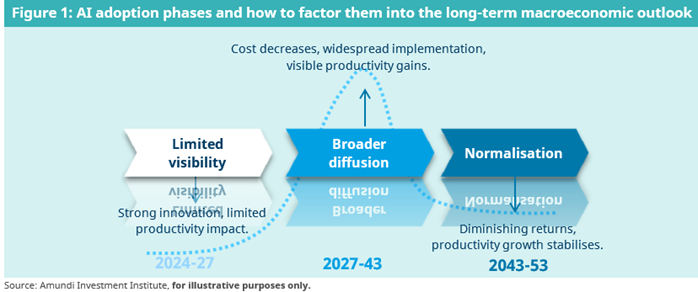
AI uptake by companies and households appears to have increased significantly in recent months. This is one of the factors that will determine whether AI will increase productivity gains significantly. As we will show in this section, a lot of new data and statistics have been published over the past quarters, and related knowledge has improved.
In the United States, since September 2023, the Census Bureau has included questions on the adoption of AI in the fortnightly survey it conducts among a large sample of companies. In December 2024, over 6.0% of US companies in all sectors already indicated that they were using AI in their production process, compared to only 3.7% a year earlier: in a very short period of time – this share has increased significantly. Furthermore, around 9% indicated that they intended to use it within six months (this share is also increasing). These figures show that the adoption of AI by companies is rapid and that it is only in its early stages: the potential for diffusion is significant.

The adoption of generative AI by households is very rapid. A NBER working paper published in 2024 shed some light on the phenomenon and even showed that the adoption of generative AI by households was ahead of that of computers and the internet in their time. Indeed, its adoption rate among the population aged 18 to 64 is 39.4% two years after its launch, twice as high as the internet at the time. Another interesting point of this study is that roughly the same share of people surveyed indicate they are using it at work and outside of work. The diversity of tasks requested is important. For people who use it at work, we find in order of relevance it is used for: writing communications, performing administrative tasks, interpreting/translating/summarising, and searching for facts or information. For people using it outside of work, we find in order of importance it is used for: writing communications, interpreting/translating/summarising, personal assistance and research of ideas. This illustrates the potential for the development of the use of generative AI.
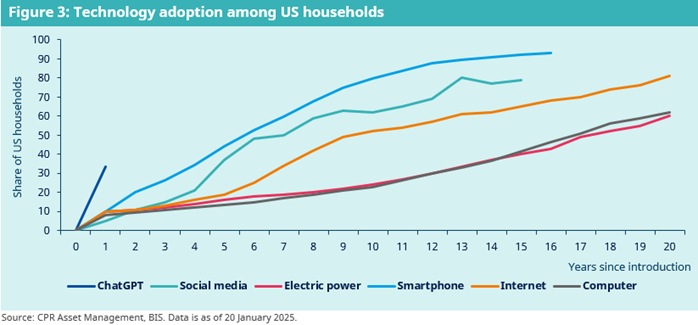
The increased focus on the importance of measuring the impact of AI in the economy is testified by the recent increase in data published on the topic. For instance, the US Census Bureau started publishing the investment breakdown with a special carve-out on data centres, highlighting the increased relevance of private investment in data centres compared with the total. Also, it recently published a special focus on employment in data centres in its Quarterly Workforce Indicators, showing that employment in US data centres increased more than 60% nationally from 2016 to 2023, with the two most populous US states having the nation’s highest share of data centre employment, at 17% in California and 10% in Texas.
Empirical studies focusing on a bottom-up and microeconomic perspective highlight that productivity gains enabled by AI can be spectacular at the sector level. Empirical studies on a top-down, macroeconomic level remain less conclusive than bottom-up ones, due to the complexity of measuring productivity on an aggregate scale. Yet, official institutions are increasingly working on the topic as it is of clear relevance for policymakers.
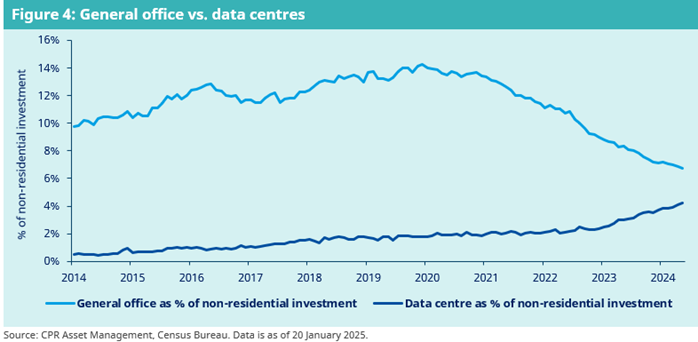
Numerous sector-level studies have been published in 2024. An MIT study is one example. The researcher was allowed to follow the scientific teams of a large US company in the materials engineering sector for several years. This company deployed AI tools in several waves, which made it possible to measure the productivity gains of scientists linked to AI. The paper shows that – all other things being equal – AI-assisted scientists discover 44% more materials. This influx of materials led to a 39% increase in patent filings and, several months later, a 17% rise in product prototypes incorporating the new compounds. Accounting for input costs, the tool boosts R&D efficiency by 13-15%. The same type of results has been found in the pharmaceutical industry, as increasing numbers of drugs and vaccines have been discovered with AI. The success rates for AI-discovered molecules in Phase I and II trials are roughly twice that of molecules discovered in a conventional way, which would enable companies either to achieve the same output with fewer resources and cost, or to increase the total number of new drugs launched with the same resources.
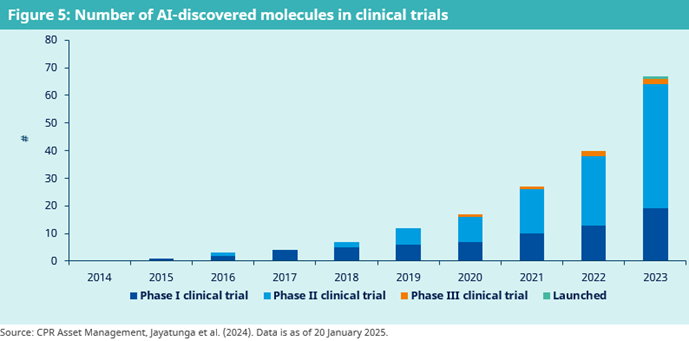
Empirical studies at the macroeconomic level are less conclusive due to the complexity of productivity measurement on an aggregate scale. A flurry of estimates – several of which are from international institutions like the IMF and the OECD – on the impact of AI on productivity have been published in 2023-24. They focus on different countries and make different assumptions on key factors, such as: speed of adoption of AI by companies, adequacy of skills for adoption, future progress in AI models, degree of integration with robotisation for the most manual tasks, public policies to promote/slow the adoption of AI, etc. Thus, it is understandable that they reach very different conclusions on the economic impact. Nevertheless, they all agree that the productivity gains enabled by AI over the coming decades will be significant on the macroeconomic level, with several of them concluding that annual labour productivity growth should increase by around 1pp in the coming decade. While this finding is generally positive and promising, it remains to be seen whether the positive impact of AI will be enough to counteract the negative effect on economic growth of population ageing that is taking place in both developed and emerging economies.
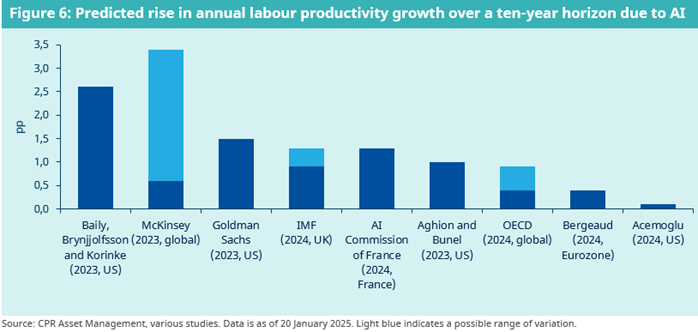
The main message from the above studies is that AI is a theme with broad macroeconomic and financial implications. As such, we are incorporating it explicitly in our long-term Capital Market Assumptions publication and are progressing our analysis by differentiating across economies based on a mix of structural and institutional characteristics that allow us to identify leaders and laggards on productivity-driven AI across both developed and emerging economies. Interestingly, some emerging economies appear well positioned among the leaders in AI preparedness and adoption.
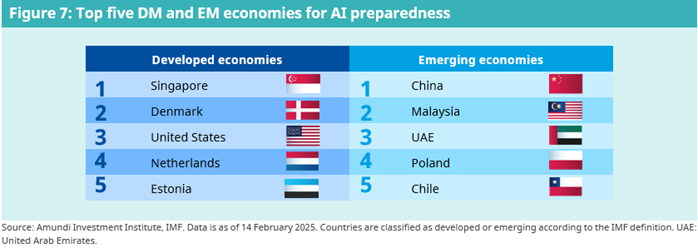
BOX 1: Analysis and implementation in long-term macroeconomic projections
In our long-term analysis, we model the impact of AI on potential growth mainly through total factor productivity (TFP) and two other key aspects related to new technology adoption: investments and capital obsolescence (depreciation rate). We focus on modelling long-term trends and potential growth, without explicitly modelling the short- and medium-term effects of AI adoption on the labour market, such as potential labour market dislocations that could cause fluctuations in growth. A gradual adoption of AI and regulation may limit the negative labour market impact. Our choice is based on evidence of a gradual economy-wide adoption of AI and a limited negative effect on labour demand. Some studies find that while AI-related job openings are on the rise, AI-related layoff announcements have been subdued, with unemployment rates for AI-exposed positions not rising compared to the overall unemployment rate. The limited adoption rate and labour market frictions are reflected in our model through parameters that constrain AI’s early productivity impact. These constraints arise from the mix of structural and institutional factors, including digital infrastructure, innovation, economic integration, human capital quality, labour market policies, regulation, and ethics. These elements are incorporated into the IMF AI Preparedness Index (see box below), which we use to model the speed of AI adoption across countries.
How to shape productivity increases over the next decades
The path followed by the productivity increase is shaped according to both theory and empirical evidence:
Over the past century, the United States experienced two waves of rapid productivity growth. The first one took place in the 1950-60s, thanks to the full exploitation of earlier innovations like electrification, infrastructure development, and the widespread use of consumer durables. The second wave happened in the late 1990s-early 2000s and was related to the widespread use of personal computers and the internet. In both cases, it took several years before the initial innovation showed up in stronger productivity growth.
On the first point, we choose to model the curves of TFP, depreciation rates and non-residential investment growth on the US patterns experienced in the 1990-2000s. We choose these dynamics as we think that recent data, while showing huge investment, still points to a gradual adoption rate among businesses and sectors. St. Louis Fed research shows contrasting patterns of adoption of recent new technologies, hinting at many possible paths that AI could take. Also, early evidence on the diffusion of AI confirms a gradual spread across the economy.
We use the IMF AI Preparedness Index and its sub-components (see box below) to differentiate the starting point across economies, while aspects such as regulation, innovation intensity and capital availability limit the peak and speed of productivity gains over time. According to these factors, productivity, capital investment and capital depreciation are modelled to estimate the impact of productivity on potential GDP growth.
BOX 2: AI Preparedness Index (AIPI)
The AIPI is an index produced by the IMF and designed to assess the level of AI preparedness (as of 2023) across 174 countries. It is based on a comprehensive set of macro-structural indicators grouped across four key dimensions able to summarise the preparedness of a country to fully exploit the potential of AI: digital infrastructure, human capital, technological innovation and legal frameworks. Each sub-dimension is computed from a rich set of sub-indicators, both quantitative and qualitative, that contribute to qualify the specific ‘ecosystem’ as more or less fertile for AI diffusion. Dimensions are divided into two waves: foundational AI preparedness indicators (digital infrastructure and human capital) and second-generation AI preparedness (innovation and economic integration). For example, the digital infrastructure dimension permits an assessment of how accessible, affordable and secure internet access is (e.g., estimated number of internet users per 100 inhabitants, number of mobile subscribers per 100 inhabitants, number of main fixed telephone lines per 100 inhabitants); while, on the other, it considers how mature the e-commerce infrastructure is (e.g., private sector’s e-commerce business environment, public sector’s online services). On human capital and labour market policies, data collected aims to get the picture of the education and digital skills of the population (e.g., public education expenditure, mean years of schooling, expected years of schooling, gross enrolment ratio, adult literacy, number of STEM graduates), and labour market flexibility and policies (e.g., flexibility of wage determination, pay and productivity, active labour market policies, social protections). According to the most recent findings, advanced economies are readier than emerging market countries to adopt AI, and the United States is the most advanced country in all respects. However, some emerging economies appear well-positioned among the leaders in AI preparedness and adoption.

Source: Amundi Investment Institute, IMF. Data is as of 20 January 2025.
Starting point: We use the AIPI (latest available data as of 2023) as a starting point across economies. This index covers multiple areas for AI readiness and is made up of a selected set of macro-structural indicators deemed to be relevant for AI adoption, organised in four groups:
Countries are then ranked accordingly. This is our starting point for simulations: the lower the rank, the smaller the productivity gain.
Productivity: The productivity gain is shaped similarly to the US curve experienced in the 1990-2000s. The peak is modelled to be hit on average 14 years after AI introduction. Yet, according to each country’s readiness, the productivity gain both at peak and along the curve varies across countries based on the AIPI and other parameters representing regulation and likelihood of success. Regulation identifies those countries where red tape makes innovation slower and the economic impact mode gradual. ‘Likelihood of success’ differentiates countries based on the probability of their investment in innovation to translate into widespread gains.
Depreciation rate: This index is also modelled on the US experience in the 1990-2000s period, assuming that, when a new technology is introduced, the existing capital becomes obsolete more quickly than before. Depreciation rates are differentiated across countries based on the AIPI.
Investment and capex: As capital becomes obsolete faster, new investment is required. We assume that the investment side will also react to the technology revolution, with a pickup in capex. However, higher capex may not translate into evident benefits in terms of productivity, especially in the early phases, given high depreciation and the limited likelihood of success.
Considering all the above elements, we expect the United States to be an early winner in the first decade of AI adoption, with an estimated contribution to GDP growth from the AI boost to productivity of about 0.35pp. DM Europe will follow in the second decade, with a lower contribution to GDP growth (around 0.3pp), while Asia lags behind in the estimated impact despite some of its economies currently ranking among the top ones for AI preparedness. For Asia, we see the contribution to GDP growth as only 0.14pp in the second decade of AI adoption. These results can be well explained by looking at the regulation sub-index in the AIPI, which is key in the case of innovation diffusion: it is penalising for Asia compared to Europe, and penalising for Europe compared to North America. The latter has less red tape than the other regions, so it can adopt any innovation more quickly. In figure 8, the peculiar dynamics shown for LatAm – which will peak in the second decade and then the contribution to growth will fall back – could be explained by the lack of investment in LatAm, which prevents AI from supporting GDP growth more forcefully.
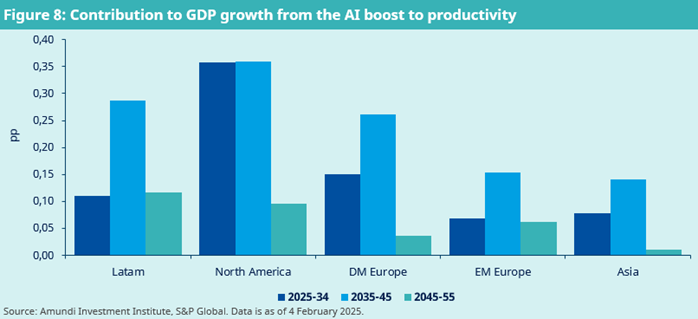
Recent developments in AI highlight how quickly the tech sector evolves, impacting companies that have built competitive advantages and sparking investor enthusiasm in recent months. For these companies, the arrival of DeepSeek (China’s new entrant in the field of AI) and of more efficient open-source AI models increases uncertainty regarding the future earnings path. However, from a macroeconomic standpoint, we see it as a possible turning point for AI adoption, showing that the AI theme is not over, but is evolving.
In particular, cost efficiency is a key driver of technological diffusion, explained by a key concept for the AI revolution, the Jevons paradox. This states that increased efficiency in a technology can lead to the increased consumption of a certain resource as the technology becomes more affordable; higher efficiency will not necessarily translate into lower investment, but likely the opposite. The AI investment that was unfeasible for many small companies, now becomes affordable. AI investment becomes more broad-based and potentially much higher in compounded terms on the overall economy. Trends in normalisation in AI-related capex among the Magnificent 7 are pointing in this direction, as we expect to move from a phase of concentrated AI capex, to a phase of possible wider adoption. In fact, lower costs for AI models could lead to faster adoption by both corporates and households, higher spending, and aggregate investment for AI, boosting aggregate productivity.
To sum up, we expect the AI trend to drive economic and market outcomes. The latest events align with our view that continued competition and innovation are likely to create winners and losers, and help broaden the benefits of the new technology across the economy by lowering barriers to entry, accelerating adoption, and creating new opportunities.
Amundi Research Center I January 2024 I Will Artificial Intelligence increase economic growth?